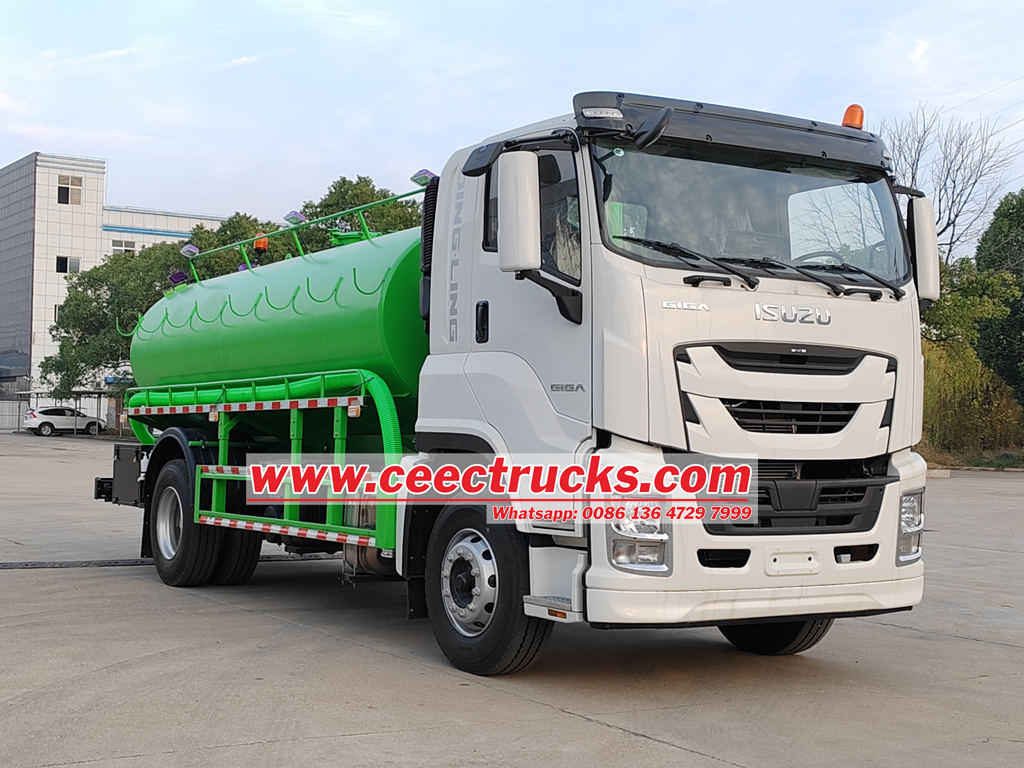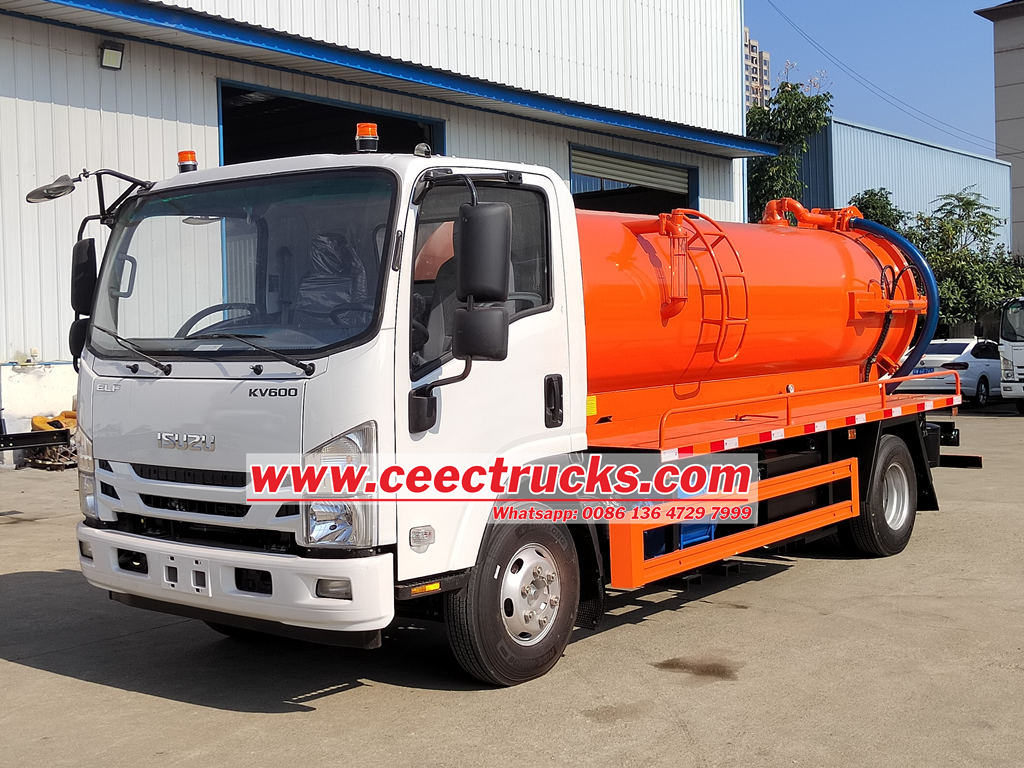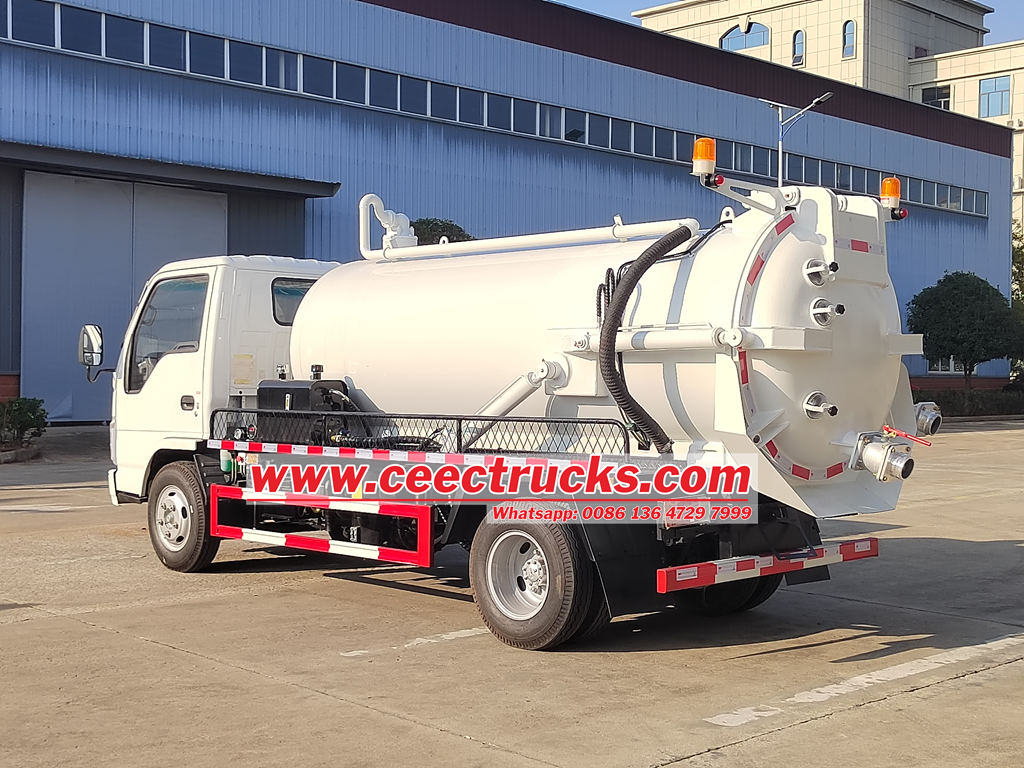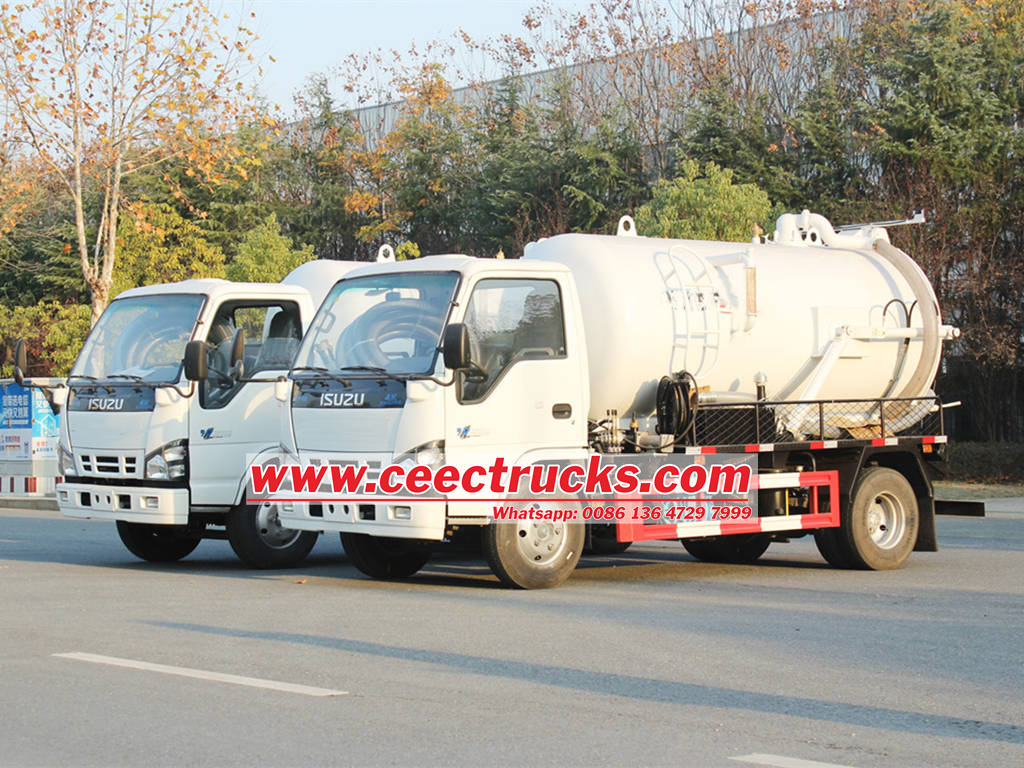
In the fields of environmental protection and cleaning, the ISUZU vacuum sewage suction truck has become a popular choice in the market due to its outstanding performance and reliable quality. As an expert in the field of vacuum sewage suction trucks, this article will provide a detailed introduction to the working principle of the ISUZU vacuum sewage truck, helping you better understand this efficient and convenient cleaning tool.

I. Overview of the ISUZU Vacuum Sewage Suction Truck
The ISUZU vacuum sewage suction truck, also known as a sewage suction truck or a suction truck, is a specialized vehicle that utilizes vacuum negative pressure to suck fecal matter and liquid waste into an on-board storage container, achieving containerized fecal matter collection and reducing secondary pollution. It is widely used in urban sanitation, municipal construction, industrial wastewater treatment, and other fields, and is widely welcomed by the market for its efficiency and convenience.
The ISUZU vacuum sewage suction truck mainly consists of an original chassis, a vacuum sewage suction pump, a power take-off (PTO), a transmission shaft, a water-air separator, an oil-air separator, a multi-way directional valve, a tank, a discharge valve, a sight glass, a vacuum pressure gauge, a piping network system, a hydraulic system, and an operating system. These components work together to complete the tasks of sewage suction, transportation, and discharge.
II. Working Principle of the ISUZU Vacuum Sewage Suction Truck
The working principle of the ISUZU vacuum sewage suction truck is mainly based on the vacuum negative pressure principle. The vacuum sewage suction pump extracts air from the tank, creating a negative pressure environment, which sucks external sewage, sludge, and other waste into the tank. The specific process is as follows:
1. Startup of the Vacuum Sewage Suction Pump
When the vehicle is started and the PTO gear is engaged, the vacuum sewage suction pump begins to operate. The pump obtains power from the chassis engine via the transmission shaft, extracting air from the tank to create a negative pressure environment.
2. Sewage Suction Process
As the vacuum sewage suction pump operates, the pressure inside the tank gradually decreases, forming a negative pressure. At this point, the suction hose is connected to the sewage or sludge source that needs to be cleaned. Due to the pressure difference between the inside and outside of the tank, the waste is sucked into the suction hose and enters the tank through the piping network system.
During the suction process, the water-air separator and oil-air separator play key roles. The water-air separator separates gas and water from the waste to prevent gas from entering the vacuum pump system, while the oil-air separator separates oil and impurities from the waste to protect the vacuum pump from damage.
3. Waste Storage
The waste sucked into the tank is stored there. The tank is made of high-strength, corrosion-resistant materials and can withstand significant pressure and impact. Additionally, the tank is equipped with baffles to prevent the waste from sloshing during transportation.
4. Discharge Process
When the tank is full of waste, it needs to be discharged. The discharge process can be achieved through various methods, such as gravity discharge or pressure discharge. During the discharge process, the discharge valve or rear cover of the tank is first opened, and then the multi-way directional valve is operated to control the discharge of the waste. The vacuum sewage suction pump may continue to operate during the discharge process to provide additional pressure to help the waste discharge quickly.

III. Key Components and Their Functions in the ISUZU Vacuum Sewage Suction Truck
1. Vacuum Pump
The vacuum pump is one of the core components of the ISUZU vacuum pump truck. It is responsible for extracting air from the tank to create a negative pressure environment. The performance of the vacuum sewage suction pump directly affects the suction efficiency and effectiveness. The ISUZU vacuum truck typically uses a high-performance vacuum sewage suction pump with features such as strong suction power, long suction range, and stable operation.
2. Power Take-Off (PTO)
The PTO is a key component that connects the chassis engine to the vacuum sewage suction pump. It transmits power from the chassis engine to the vacuum sewage suction pump, allowing it to operate normally. The performance and reliability of the PTO are crucial for the stable operation of the entire suction system.
3. Transmission Shaft
The transmission shaft is responsible for transmitting the power from the PTO to the vacuum sewage suction pump. It is made of high-strength, corrosion-resistant materials and can withstand significant torque and impact. Additionally, the design of the transmission shaft needs to consider the vehicle's driving stability and safety.
4. Water-Gas Separator and Oil-Gas Separator
The water-gas separator and oil-gas separator are important components that protect the vacuum pump from damage. They separate gas, water, and oil impurities from the waste to prevent these impurities from entering the vacuum pump system and causing damage.
5. Tank
The tank is a key component for storing waste in the ISUZU sewer vacuum truck. It is made of high-strength, corrosion-resistant materials and can withstand significant pressure and impact. Additionally, the tank is equipped with baffles to prevent the waste from sloshing during transportation. The design and capacity of the tank directly affect the suction efficiency and effectiveness.
6. Multi-Way Directional Valve
The multi-way directional valve is a key component for controlling the suction and discharge processes. It can achieve functions such as suction, discharge, and stop through different operating positions. The design and performance of the multi-way directional valve are crucial for the stability and safety of the entire suction system.

IV. Operating Precautions for the ISUZU Vacuum Septic Tank Truck
To ensure the normal operation and extend the service life of the ISUZU vacuum tank truck, operators should pay attention to the following precautions:
1. Pre-start Inspection
Before operating the ISUZU vacuum sewage suction truck, a comprehensive inspection of the vehicle is required. This includes checking the working status of the chassis engine, vacuum sewage suction pump, PTO, transmission shaft, and other components; inspecting the suction hose, piping network system, tank, and other components for damage; and checking the sufficiency of hydraulic oil, lubricant, etc.
2. Precautions During the Suction Process
During the suction process, the following precautions should be taken:
★ Ensure that the suction inlet is tightly connected to the waste source to avoid air leaks.
★ Control the suction speed and time to prevent the tank from overfilling or the suction hose from becoming clogged.
★ Regularly check the working status of the vacuum sewage suction pump, and stop the truck for inspection if any abnormalities are found.
3. Precautions During the Discharge Process
During the discharge process, the following precautions should be taken:
★ Ensure that the discharge outlet is unobstructed to avoid waste residue or clogging.
★ Control the discharge speed and pressure to prevent waste from splashing or causing environmental pollution.
★ Regularly check the cleanliness of the inside of the tank and the discharge system, and clean and maintain them if necessary.
4. Safety Precautions
When operating the ISUZU vacuum sewage suction truck, the following safety precautions should be taken:
★ Obey traffic rules and safety operating procedures to ensure driving safety.
★ Wear personal protective equipment such as safety helmets, protective clothing, and gloves during operation.
★ Avoid operating the vehicle in flammable, explosive, or toxic environments.
The ISUZU vacuum sewage suction truck has become a popular choice in the market due to its outstanding performance and reliable quality. Its working principle is based on the vacuum negative pressure principle, where the vacuum sewage suction pump extracts air from the tank to create a negative pressure environment, sucking external sewage, sludge, and other waste into the tank. Key components such as the vacuum sewage suction pump, PTO, transmission shaft, etc., work together to complete the tasks of sewage suction, transportation, and discharge. During operation, safety precautions and operating procedures should be followed to ensure the normal operation of the vehicle and extend its service life.
